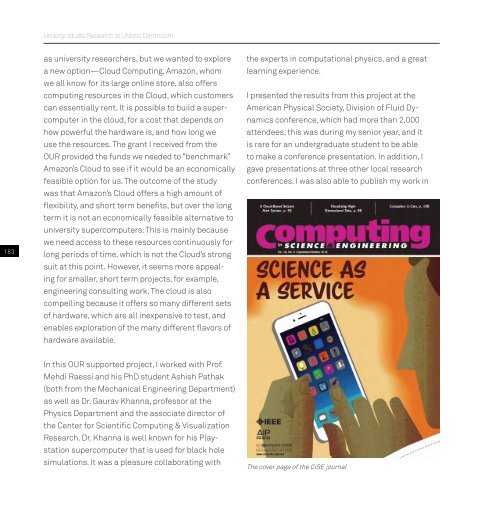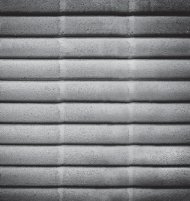Undergrad_Book_16-18_Pge_View_Print_no print marks_compressed
You also want an ePaper? Increase the reach of your titles
YUMPU automatically turns print PDFs into web optimized ePapers that Google loves.
<strong>Undergrad</strong>uate Research at UMass Dartmouth<br />
<strong>18</strong>3<br />
as university researchers, but we wanted to explore<br />
a new option—Cloud Computing. Amazon, whom<br />
we all k<strong>no</strong>w for its large online store, also offers<br />
computing resources in the Cloud, which customers<br />
can essentially rent. It is possible to build a supercomputer<br />
in the cloud, for a cost that depends on<br />
how powerful the hardware is, and how long we<br />
use the resources. The grant I received from the<br />
OUR provided the funds we needed to “benchmark”<br />
Amazon’s Cloud to see if it would be an eco<strong>no</strong>mically<br />
feasible option for us. The outcome of the study<br />
was that Amazon’s Cloud offers a high amount of<br />
flexibility, and short term benefits, but over the long<br />
term it is <strong>no</strong>t an eco<strong>no</strong>mically feasible alternative to<br />
university supercomputers. This is mainly because<br />
we need access to these resources continuously for<br />
long periods of time, which is <strong>no</strong>t the Cloud’s strong<br />
suit at this point. However, it seems more appealing<br />
for smaller, short term projects, for example,<br />
engineering consulting work. The cloud is also<br />
compelling because it offers so many different sets<br />
of hardware, which are all inexpensive to test, and<br />
enables exploration of the many different flavors of<br />
hardware available.<br />
the experts in computational physics, and a great<br />
learning experience.<br />
I presented the results from this project at the<br />
American Physical Society, Division of Fluid Dynamics<br />
conference, which had more than 2,000<br />
attendees; this was during my senior year, and it<br />
is rare for an undergraduate student to be able<br />
to make a conference presentation. In addition, I<br />
gave presentations at three other local research<br />
conferences. I was also able to publish my work in<br />
In this OUR supported project, I worked with Prof.<br />
Mehdi Raessi and his PhD student Ashish Pathak<br />
(both from the Mechanical Engineering Department)<br />
as well as Dr. Gaurav Khanna, professor at the<br />
Physics Department and the associate director of<br />
the Center for Scientific Computing & Visualization<br />
Research. Dr. Khanna is well k<strong>no</strong>wn for his Playstation<br />
supercomputer that is used for black hole<br />
simulations. It was a pleasure collaborating with<br />
The cover page of the CiSE journal



